Joseph Herrin (05-20-2015)

There is a reason I highlighted the word “TOE” in the above graphic. It was the consideration of toes that prompted me to write this particular post. This will be explained as you continue to read.
I have shared recently that about 5 and ½ weeks ago I injured my right knee when I fell outside while tending to some dogs in the wee hours of the morning. Rehab has been somewhat painful. I have not gone to the doctor, so when I speak of rehab, I am not referring to visits to a physical therapist and sessions on their various machines. My therapy has been mowing the grass in the rather extensive yard surrounding my bus, and taking walks down the road. Soon, I hope it will include lengthy rides on my recumbent trike which I am in the process of upgrading/repairing. I am still awaiting some parts which should arrive soon.
Mowing grass is therapeutic in many ways. I have always enjoyed walking behind a push mower, an activity I began as a young boy when my father assigned the cutting of the yard to me. I soon was mowing grass for the neighbors to earn a little spending money. Into my adult years I have found mowing grass to continue to be enjoyable, and beneficial to my physical and spiritual health. It is emotionally relaxing even when I am pouring sweat as I mow the yard in the hot Georgia summer. I look forward to the reward of a large slice of watermelon afterwards. But I digress…
Since my recent injury, I am wearing a brace, but it does not eliminate much of the pain I feel in the knee. The knee is still healing. I am accustomed to such pains since I was born with a hereditary bone disease known as Osteogenesis Imperfecta, commonly referred to as “Brittle Bone Disease.” I broke my first bone at the age of seven (my right thumb), and by the age of 14 I had broken about 7 more bones, including chipping my elbows three times requiring surgery to pin them back in place.
I was fortunate to have a hiatus from broken bones from the age of 15 until I was in my mid thirties. At that time a fall on a freshly waxed floor at work resulted in a broken ankle and a partial tear to the anterior cruciate ligament in my right knee, the same knee that is now giving me problems. Four years ago, when I was fifty, I experienced additional broken bones when a woman, 91 years of age, drove her large car into my left lower leg when I was riding my motorcycle. That resulted in a crushed fibula, a compound fracture of the ankle, and required two titanium plates and more than twenty screws to piece everything back together.
My most recent fracture occurred two years ago when I took a tumble off of my bike while running my dog Champ down a sandy road on Jekyll Island. I cracked some ribs with that fall, and dislocated my index finger on my left hand. I popped the finger back into place myself. I didn’t seek medical treatment as I was fairly certain of my injuries and knew that the doctor would recommend rest to give the ribs time to heal. Most doctors don’t recommend wrapping broken ribs anymore, so there is little in the way of treatment.
At this time, I have lost count of how many broken bones I have had in life. Some may want to scold me for not going to the doctor every time I am injured, but I have not sensed the Father directing me to do so. Also, due to the frequency of this type of injury in my life, they do not traumatize me as much as they might other individuals. I have grown accustomed to them. They are a part of life.
One aspect of Osteogenesis Imperfecta that does not get as much attention is that it also causes the individual to have a greater laxity in their joints. I am double jointed in my thumbs, the demonstration of which can often amuse children. A less amusing manifestation of this slackness in the joints is that I have dislocated both of my shoulders on numerous occasions. The first time this occurred (to my remembrance) was when I was about 19 years old. It happened playing ball with some friends. They loaded me up in one of their vehicles to take me to the emergency services, but the shoulder popped back in by itself just as we pulled up. It was mighty sore for weeks, and after that it would pop out on occasion, but never with the same degree of pain, and I was always able to pop it right back into place if it did not do so itself, which it normally did. The last time I dislocated a shoulder was when I was knocked off my motorcycle at the age of 50.
For those who are not familiar with my life, I did give up motorcycle riding after the accident. I also switched from a bicycle to a recumbent trike after the accident running my dog. I recently marked my 54th birthday, and although I have learned to tolerate bodily injuries with patience and grace, I don’t want to court additional spills and thrills.
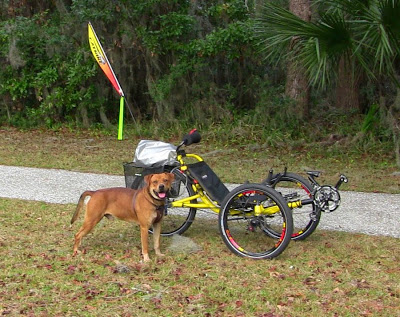
Champ and My Catrike
Because I live full-time in an RV and I pull a trailer behind it, I am unable to tow a car. That was the reason I purchased the motorcycle, as I could haul it with me when relocating. Now I use my recumbent trike for local transportation. I mounted an electric motor on it and it serves me quite well while also affording me some much needed exercise as I make the 30 mile round-trip to town to collect my ministry mail and do my grocery shopping.
I am located in a rural section of Georgia and I have never seen another recumbent trike around here. I get quite a bit of reaction when I ride my trike into town, pulling my little bike trailer behind it. It turns a lot of heads. Children point and wave. People approach me quite often when I am in town and ask me about it. It is an unusual form of conveyance when every other person is driving gas and diesel powered automobiles around. Yet, it is ideal for my needs and I am grateful for the Father, and those saints, whose gracious gifts enabled me to acquire it.
The trike doesn’t require fill-ups at the gas station. I don’t have to carry insurance on it. I don’t have to buy annual tags for it. It is suitable for trips to town or for running my dog. It provides me with exercise and the enjoyment of being out of doors. Not having a car also discourages me from making those impulse runs to town to satisfy some craving of the flesh. When it takes two hours to bike to town and back you think carefully about how much you need that trip to Subway or Chick-fil-a.

My manner of living, having converted an old school bus into a motorhome, and riding a recumbent trike around, not having a “real job,” as I follow the Lord wherever He leads, filling my days with the ministerial calling appointed to me, is viewed as unorthodox by many people. Yet, I have to question what makes the traditional lifestyle and forms of living more acceptable or praiseworthy than those which are non-traditional. Most people have adopted their way of life because it has been pressed upon them. It is how their parents lived, and their grandparents before them. It is how everyone else around lives. Consequently, most people never consider doing things differently.
As a Christian, this is especially problematic. As I observe the call of Christian discipleship in the New Testament, I find that Yahshua was constantly calling men away from the normal manner of living common in their society, and inviting them to follow Him down paths that were unconventional.
Mark 10:29-31
Yahshua said, “Truly I say to you, there is no one who has left house or brothers or sisters or mother or father or children or farms, for My sake and for the gospel’s sake, but that he shall receive a hundred times as much now in the present age, houses and brothers and sisters and mothers and children and farms, along with persecutions; and in the age to come, eternal life.”
Yahshua spoke these words right after He had invited the rich, young ruler to sell all he had, give the money to the poor, and come follow Him. The invitation was full of possibilities. There was no way of foretelling what manner of life and experiences the young man would have if he accepted Christ’s invitation. Yet, one thing was certain. It would be different from the life he had become accustomed to.
I have found that as I embrace a life outside the box, a life different from what I formerly knew from my childhood until the age of 38, that I have come to be more open-minded, more accepting of change, more willing to do things differently than those around me. This includes doing things differently than my fellow Christians as well. In the past sixteen years I have rarely attended a church service. This has not been because I was unwilling to do so, but rather that the Father has not directed me to do so. I have been led (at times thrust) outside the camp. This has caused me to be far more open to being taught of the Spirit, and teach me He has. The Spirit of Christ has led me to reconsider many of the doctrines delivered to me when I was a member of various churches. He has given me revelation of truth that has brought me into conflict with those who are ensnared in orthodoxy, an orthodoxy that is leavened with error. Many are not willing to accept any doctrine that is “outside the box” of their pedagogical upbringing.

Those who cling to teachings because they are orthodox, or hold to processes because they are standard operating procedure, or acquire things because they are what everyone else has, will do injury to themselves and others. As the sons (male and female) of God, we should question more, be teachable, and prove ourselves ready to adapt and innovate when the Father gives us revelation of truth, or a better way of doing things.
Yesterday I considered a curious example of thinking outside the box. It has to do with toes. When I was a child I remember my father encouraging my siblings and I to walk on our toes to help strengthen our feet and legs. My parents had four children, and three of us inherited the brittle bones that my father was born with, and his mother before him. Along with the brittle bones, I also had/have flat feet. When I walk barefoot they flap (Grin)

What my father did not know was that the typical shoe works against the health of the foot, and of the rest of the body as well. It is akin to wearing a pair of boxes over your feet. When a person walks or runs barefooted they naturally land on the ball of their foot.
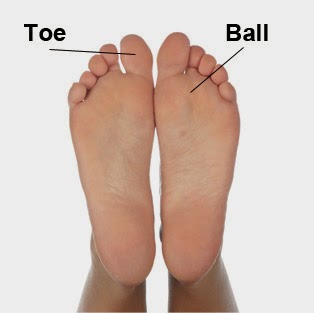
However, by placing an elevated heel on a shoe, the dynamics of walking and running are changed so that the heel is the first part of the foot to strike the ground. What this does is to remove the ankle’s motion from the act of walking and running. Rather than landing on the ball of the foot and allowing the ankle to flex, acting as a natural shock absorber, when a person lands on their heel, the force is transferred directly up to the knee resulting in a much greater strain to the knee. In turn, there is also a greater impact on the hips. The lower back is also impacted negatively, and this is all caused by the shape and structure of the typical shoe.
Even tennis shoes, or athletic shoes, have raised heels, and this encourages people to run on their heels rather than on the balls of their feet. This is a large part of the reason that so many runners are afflicted with knee, hip, or lower back problems.
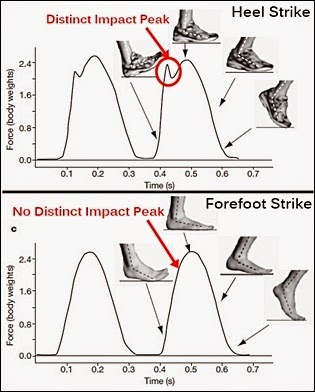
Running Shoes Exert More Stress on Joints Than Running Barefoot
In a study published in the December 2009 issue of “PM&R: The journal of injury, function and rehabilitation,” researchers compared the effects on knee, hip and ankle joint motions of running barefoot versus running in modern running shoes. They concluded that running shoes exerted more stress on these joints compared to running barefoot…
Sixty-eight healthy young adult runners (37 women), who run in typical, currently available running shoes, were selected from the general population. None had any history of musculoskeletal injury and each ran at least 15 miles per week. A running shoe, selected for its neutral classification and design characteristics typical of most running footwear, was provided to all runners. Using a treadmill and a motion analysis system, each subject was observed running barefoot and with shoes. Data were collected at each runner’s comfortable running pace after a warm-up period.
The researchers observed increased joint torques at the hip, knee and ankle with running shoes compared with running barefoot. Disproportionately large increases were observed in the hip internal rotation torque and in the knee flexion and knee varus torques. An average 54% increase in the hip internal rotation torque, a 36% increase in knee flexion torque, and a 38% increase in knee varus torque were measured when running in running shoes compared with barefoot.
These findings confirm that while the typical construction of modern-day running shoes provides good support and protection of the foot itself, one negative effect is the increased stress on each of the 3 lower extremity joints. These increases are likely caused in large part by an elevated heel and increased material under the medial arch, both characteristic of today’s running shoes.
[Source: http://www.sciencedaily.com/releases/2010/01/100104122310.htm]
Isn’t this amazing? Athletic shoe sales generate tens of billions of dollars annually. In 2013 Nike had sales of $23 billion, and Adidas was not far behind with sales of $20 billion. You would think with such massive profit to be garnered in this area that companies would be investing billions in research and development to come up with the ultimate shoe to facilitate speed, comfort and body health. Yet this is not the case. Sure, these companies do invest in R&D. They employ space age composites and light weight materials. But what they have not done is stray from the orthodox, accepted style of shoe that people are familiar with. Not having any breakthrough technology to sell their wares, they resort to star appeal by signing up sports heroes to endorse their shoes. (Air Jordan’s, anyone?)
What hinders innovation is that shoe manufacturers, just like automobile or furniture manufacturers, realize that selling anything that is radically different is difficult. People are comfortable with that which is familiar. They might change the color, or the fabric used in the design of a shoe; they may innovate with tread patterns or by adding some shock absorbing feature into a shoe, but the general design and overall look remains recognizable. If it were too radical the majority of people would not purchase it.
Sadly, the same phenomena occurs when it comes to Bible sales. There have been many Bible versions produced that attempt to differentiate themselves from others. Yet a common failing is that translators will not faithfully render the original Hebrew or Greek into English if doing so would upset the majority of their target audience. Many times there have been meetings where the executive oversight committees for specific Bible translations have given instructions to the translators to not translate anything in such a way that it would offend the masses who hold to specific doctrines, no matter what the original text states. This has occurred far more often than most people realize. After all, the highest rule of a Bible seller is that it the Bible they produce must sell. If you produce a Bible, no matter how faithful to the original, that goes against the orthodoxy of the day, it will not sell. Therefore, what one finds filling the shelves of the Bible bookstores are translations that maintain the orthodoxy of the hour.
An example of this is in the near universal editorial policy of all popular English Bibles to refuse to translate the Tetragrammaton (the four letters that spell the name of God) into English. Instead, they have all adopted the practice of replacing the name of Yahweh with a titular substitute which is no name at all. Pick up your KJV, NASB, NIV, NLT, Amplified, or other popular Bible and you will find that “Lord,” “God,” and “Lord God” are used universally while the actual name of the God of creation is omitted. Such an editorial policy is unconscionable, but the editors know that if they strayed from this orthodox practice which began with the rabbinic, Talmudic Jews, that the sales of their translations would plummet.
If the editors of the NIV Bible produced a new release where God and Lord had correctly been replaced by Yahweh in the more than 6,800 instances in which the name occurs in the Old Testament, or where they translated the Greek “aion” as “age” rather than as some form of the words “eternal,” or “forever,” the people who fill the pews would say, “This is not what I am used to. I don’t like it. This isn’t what my mother’s Bible said.” Thus truth lies forsaken, having been sacrificed on the altar of a false orthodoxy.
What if there were a shoe company that embraced the philosophy that the best engineering is already present in the human body and that a shoe should work with, and not against, this inherent technology? What if a shoe company sought to design a shoe that got out of the way, not hindering the natural movement of the foot, or the natural stride of mankind? What kind of shoe might they design? They would likely be minimalist in appearance since wrapping the foot in some boxy container, or adding an elevated heel or ultra thick sole would force the body to operate in an unnatural manner. Such a minimalist shoe might look like the Vibram Five Fingers line of footwear.
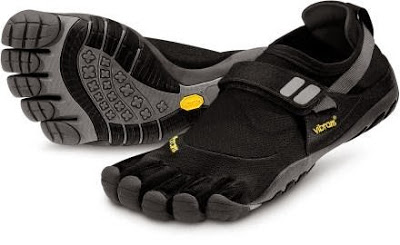
Vibram Five Fingers TrekSport
If your reaction to this shoe is that it looks like a glove for the foot, then I would encourage you to continue with that thought. What good would a glove for the hand be if it restricted or altered the motion of your fingers, palm, and wrist? We don’t wear bulky boxes on our hands that are akin to what we find in the typical shoe for the very reason that we need our hands to function freely as they were designed to do. So why do we view the foot differently?
There are actually a small number of shoe companies that sell what are advertised as “minimalist” or “barefoot” shoes. Vibram is one of those companies. Fila also sells a line called Skele Toes, and there is another small company called Vivobarefoot which sells mimimalist shoes, but the shoes do not have separated toes as do the Vibram Five Fingers and Fila Skele Toes.
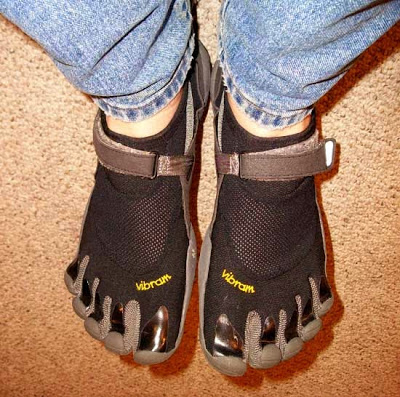
Undoubtedly, if you wear these shoes to the office, or out in public, you are going to turn a few heads. Someone might accuse you of having gorilla feet. Would that matter to you if these shoes corrected your gait and returned you to a natural form of walking and running that encouraged you to land on the balls of your feet rather than pounding the pavement with your heels? Would the unorthodox appearance turn you off if these shoes alleviated your knee or other joint pains and made walking and running a pleasure again?
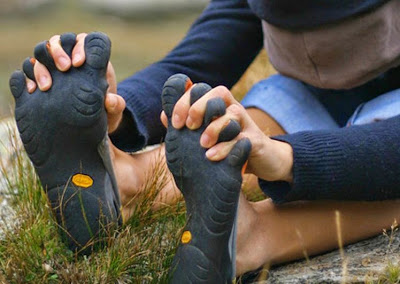
https://youtu.be/uglIacSx164?t=48s
Having observed that there are thousands of reviews for these shoes on Amazon, and the average rating for any model of shoe in this line is 4.5 out of 5 stars with a multitude of glowing reviews about how these shoes changed a person’s life, allowing them to run again without pain, etc., it would seem there is some merit to adopting the unorthodox, and thinking outside the box.
Soon, the people of these small rural towns of South Central Georgia where I reside will see one more oddity. Riding into town on a recumbent trike will be a bearded, bald headed man, with gorilla feet. I will let you know how that turns out.
While you are still alive, I encourage you to think outside the box. Escape from the confines of orthodoxy. Judge things on what is true, what is right, what is profitable, rather than what is the accepted norm. If the Spirit moves you, try on some Vibrams, and if you are ready for a real challenge, read the book God’s Plan of the Ages. Be forewarned, however, thinking outside the box may well get you kicked outside the camp.

Heart4God Website: http://www.heart4god.ws
Parables Blog: www.parablesblog.blogspot.com
Mailing Address:
Joseph Herrin
P.O. Box 804
Montezuma, GA 31063



0 Comments